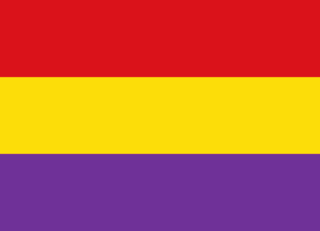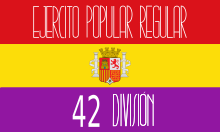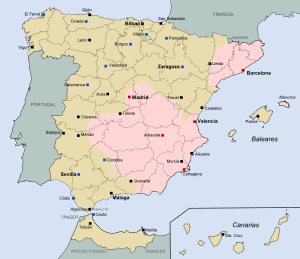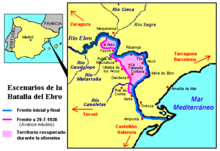
Auts is a mountain chain that is located southeast of Mequinenza, close to the Ebro river in the Bajo Cinca comarca, Aragon, Spain. Its maximum elevation is 434 metres.

The 224th Mixed Brigade was a mixed brigade of the Spanish Republican Army in the Spanish Civil War. It was formed in summer 1937 in Catalonia from scattered Coastal Defence units and had four battalions: the 893, 894, 895 and 896.

The 225th Mixed Brigade, was a mixed brigade of the Spanish Republican Army in the Spanish Civil War. It was formed in the summer of 1937 in Valencia with units belonging to the Eastern Coastal Defence and had four battalions, the 897, 898, 899 and 900.

The 227th Mixed Brigade, was a mixed brigade of the Spanish Republican Army in the Spanish Civil War. It was formed in the spring of 1938 in Catalonia and had four battalions, the 905, 906, 907 and 908.

The 226th Mixed Brigade, was a mixed brigade of the Spanish Republican Army in the Spanish Civil War. Part of its forces had belonged to the former Bautista Garcet Battalion, which had distinguished itself in the combats of the Córdoba offensive at the beginning of the Civil War. Its formation began in August 1937 in Catalonia, but it was delayed for a long time, the brigade not becoming fully operational until 1938. It had four battalions, the 901, 902, 903 and 904.

The 11th Division was a division of the Spanish Republican Army in the Spanish Civil War. It was formed in January 1937 in Madrid beginning with the 1st Mixed Brigade which in turn had originated in the Fifth Regiment.

The 77th Division was a division of the Spanish Republican Army in the Spanish Civil War. It would be the last division of the loyalist forces to be formed.

The 87th Mixed Brigade, was a mixed brigade of the Spanish Republican Army in the Spanish Civil War. It was formed in March 1937 with battalions of the Carabineros corps. Its first commander was Infantry Colonel Carlos Amores Cantos, who was succeeded by Militia Major Andrés Nieto Carmona.

The 49th Mixed Brigade, was a mixed brigade of the Spanish Republican Army in the Spanish Civil War. It was formed in February 1937 at the Guadalajara Front.

The 45th Division was a division of the Spanish Republican Army in the Spanish Civil War.

The 35th Division was a division of the Spanish Republican Army in the Spanish Civil War.
The 94th Mixed Brigade was a unit of the Spanish Republican Army created during the Spanish Civil War. It came to operate on the Teruel, Aragon and Segre fronts.
The 82nd Mixed Brigade was a unit of the Spanish Republican Army created during the Spanish Civil War. It came to operate on the Teruel and Levante fronts.
The 59th Mixed Brigade was a unit of the Spanish Republican Army created during the Spanish Civil War. It came to operate on the Teruel and Ebro fronts.
The 60th Mixed Brigade was a unit of the Spanish Republican Army created during the Spanish Civil War.
The 61st Mixed Brigade was a unit of the Spanish Republican Army that took part in the Spanish Civil War. Throughout the war, the brigade was present on the Teruel, Aragon, Levante and Extremadura fronts.
The 95th Mixed Brigade was a unit of the Spanish Republican Army that took part in the Spanish Civil War. Throughout the war, various brigades came to use the number "95", operating on various fronts.
The 67th Division was a unit of the Spanish Republican Army that existed during the Spanish Civil War, created on the basis of the mixed brigades. It came to be deployed on the fronts of Teruel, Extremadura and Levante.
The 92nd Mixed Brigade was a unit of the Spanish Republican Army created during the Spanish Civil War. It came to operate on the fronts of Andalusia, Teruel, Levante and Extremadura, having an outstanding performance during the conflict.
The 214th Mixed Brigade was a unit of the People's Army of the Republic created during the Spanish Civil War.








